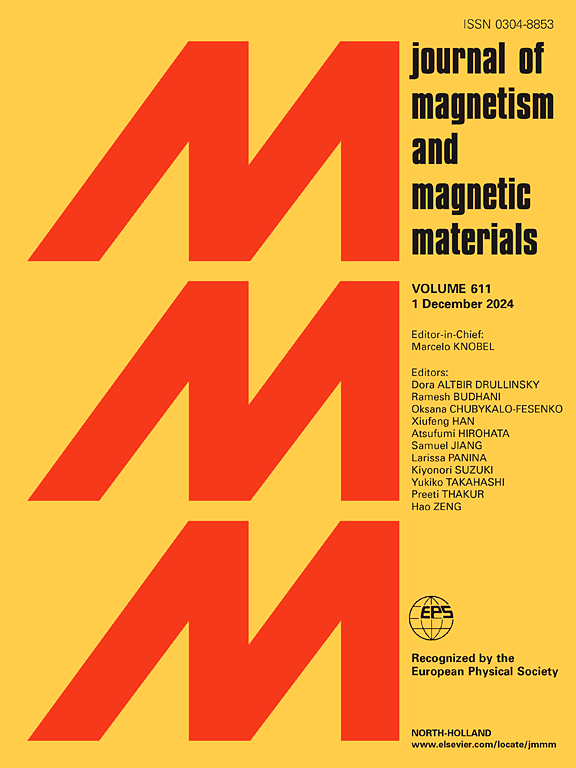超高磁导率Co66Fe3Cr3Si18B10合金带超细纳米晶结构的形成机理
IF 2.5
3区 材料科学
Q3 MATERIALS SCIENCE, MULTIDISCIPLINARY
引用次数: 0
摘要
纳米晶合金以其优异的软磁性能,特别是低矫顽力和高磁导率而受到人们的广泛关注。然而,纳米晶粒的形成依赖于快速退火,这使得纳米晶合金难以应用于工业生产。本研究采用临界冷却速率熔融纺丝和常规退火的新制备方法,制备了具有超细纳米晶结构的Co66Fe3Cr3Si18B10合金带。采用XRD、DSC、TEM等手段对条带的微观结构演化进行了表征,并对其超微晶结构的形成机理进行了探讨。结果表明,在接近临界冷却速率下,合金中形成了细小且密集分布的中阶淬火晶簇,退火60 min后,晶簇长大为均匀尺寸为4.81±1.05 nm的纳米晶晶粒。纳米晶合金的矫顽力低,为0.43 a /m,初始磁导率高,为12.44 × 104。本文章由计算机程序翻译,如有差异,请以英文原文为准。

Formation mechanism of ultra-fine nanocrystalline structure for Co66Fe3Cr3Si18B10 alloy ribbons with ultra-high permeability
Nanocrystalline alloys have attracted tremendous attention due to their excellent soft magnetic properties, especially low coercivity and high permeability. However, the formation of fine nanocrystalline grains relies on rapid annealing, which makes the nanocrystalline alloys difficult to apply in industrial production. In this study, Co66Fe3Cr3Si18B10 alloy ribbons with ultra-fine nanocrystalline structure were prepared through a novel preparation method via critical cooling rate melt-spinning and conventional annealing. The microstructure evolution of the ribbons was characterized by XRD, DSC, and TEM, and the formation mechanism of the ultra-fine nanocrystalline structure was discussed. It was found that fine and densely distributed medium-range order quenched-in clusters formed at the near-critical cooling rate, and clusters grew into nanocrystalline grains with a uniform size of 4.81 ± 1.05 nm after annealing for 60 min. The nanocrystallized alloy exhibits a low coercivity of 0.43 A/m and a high initial permeability of 12.44 × 104.
求助全文
通过发布文献求助,成功后即可免费获取论文全文。
去求助
来源期刊

Journal of Magnetism and Magnetic Materials
物理-材料科学:综合
CiteScore
5.30
自引率
11.10%
发文量
1149
审稿时长
59 days
期刊介绍:
The Journal of Magnetism and Magnetic Materials provides an important forum for the disclosure and discussion of original contributions covering the whole spectrum of topics, from basic magnetism to the technology and applications of magnetic materials. The journal encourages greater interaction between the basic and applied sub-disciplines of magnetism with comprehensive review articles, in addition to full-length contributions. In addition, other categories of contributions are welcome, including Critical Focused issues, Current Perspectives and Outreach to the General Public.
Main Categories:
Full-length articles:
Technically original research documents that report results of value to the communities that comprise the journal audience. The link between chemical, structural and microstructural properties on the one hand and magnetic properties on the other hand are encouraged.
In addition to general topics covering all areas of magnetism and magnetic materials, the full-length articles also include three sub-sections, focusing on Nanomagnetism, Spintronics and Applications.
The sub-section on Nanomagnetism contains articles on magnetic nanoparticles, nanowires, thin films, 2D materials and other nanoscale magnetic materials and their applications.
The sub-section on Spintronics contains articles on magnetoresistance, magnetoimpedance, magneto-optical phenomena, Micro-Electro-Mechanical Systems (MEMS), and other topics related to spin current control and magneto-transport phenomena. The sub-section on Applications display papers that focus on applications of magnetic materials. The applications need to show a connection to magnetism.
Review articles:
Review articles organize, clarify, and summarize existing major works in the areas covered by the Journal and provide comprehensive citations to the full spectrum of relevant literature.
 求助内容:
求助内容: 应助结果提醒方式:
应助结果提醒方式:


